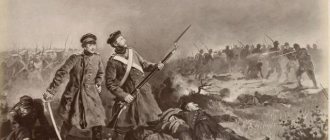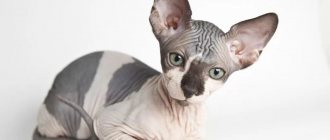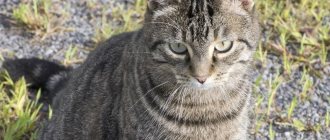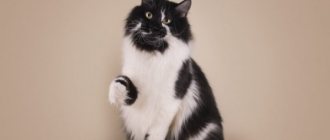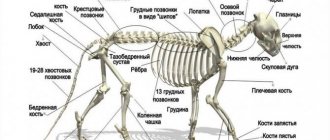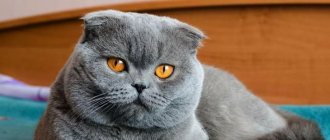History of the origin of the British cat
Judging by the name itself, it becomes clear that the homeland of these cats is Great Britain. Historians suggest that these animals were brought to the British Isles by the ancient Romans around the first century AD.
The main advantage of those ancient representatives of the British was their short and very dense coat, which provided the animals with protection from moisture and harmful insects. It was thanks to this wool that the British quickly got used to and adapted to new living conditions.
They were excellent hunters, thanks to their high levels of endurance and well-developed physical fitness.
Due to their spectacular appearance, at the end of the 16th century, British felines began to be looked at not only as skilled hunters. And already in 1871, British individuals participated in the first cat exhibition in London.
Features of care
As we said above, the British are unpretentious cats. They do not require special care either in eating or grooming.
Their maintenance is simple and will not bring much trouble.
Combing
The plush fur of the British is a pleasure to care for.
Cats need to be brushed infrequently, twice a week is enough.
This must be done with a furminator or a massage brush with steel bristles, movements should be made in the direction and against the growth of the hair.
And the rest of the days you can just run your wet palms over the fur and collect all the excess.
This type of wet cleaning should be done as often as possible so that the wool does not remain on the carpets and furniture.
It is worth bathing as needed (2-4 times a year), with special products from the pet store.
If you want to learn more about how to properly wash a cat, we recommend that you read the following article:
British cats use a special technique for washing themselves
Content
When keeping British cats, you only need to take into account that they need secluded places and some other points.
They love their privacy, preferring not to be disturbed during their alone time.
Equip several “climbing areas” with a perch for them, think about having a house and dense boxes in secluded places - believe me, your “plushies” will appreciate it.
The British are excellent hunters, they are happy to walk on the grass and chase something alive.
Give them walks in the fresh air, and don’t forget to wear a tick and flea collar .
When arranging a toilet for a cat , you should take into account that he loves to rummage, so buy a tray with high sides or a toilet house.
Apparently the kind look of the British cat allows the butterfly to feel calm sitting on his nose
Otherwise, the maintenance of the British is no different from the standards: take care of the claws (take care of the scratching post ), look after the ears and eyes, feed properly, not forgetting about clean drinking and give love.
Nutrition
The question of what to feed a British cat cannot be answered unequivocally, since it all depends on your choice ( natural or dry food ).
It is important not to overfeed the cat, because no matter how much you give them, they will eat everything, because they are real gluttons by nature.
Meals should be regular and balanced. When it comes to dry food, give preference to more expensive options, taking into account the characteristics of your pet.
If a British cat sees meat on the table, he will definitely check how fresh it is.
Speaking about natural nutrition, I would like to note that we are not talking about human food.
It is important to understand that the animal has its own characteristics of the digestive system, and it should not be given sweet, salty, fried or spicy foods.
Improper nutrition entails various disorders of the gastrointestinal tract and other organs of the animal.
Natural food for a British cat is: lean meat (boiled or scalded) and offal, cereals, vegetables, eggs, low-fat fermented milk products and water (fresh, clean).
The British cat needs to be fed 2-3 times a day.
Description of the breed
The main characteristic feature of the British is power, especially when it comes to males. Female cats are smaller in size than male cats. Squat height and rather large size, developed muscles and sternum - this is the image of a modern Briton.
The head of these cats is large with rounded outlines. The muzzle has developed cheeks and cheekbones. Only the British have a pronounced fold of skin around the neck.
The nose is medium long, rather wide. When viewed in profile, you can see that the nose forms a depression in the frontal part. The ears are located quite widely, with a wide base. The shape is rounded, the size of the ears is medium.
British people have large, round eyes. Set wide apart. What distinguishes British cats is the color of their eyes, characteristic of the breed - it is bright orange.
Newborns may have blue eyes, however, over time they will change their color. It is very rare to come across cats with blue or green eyes.
Medium or short llamas are equipped with well-developed strong muscles. The tail is of medium length and looks proportional to the body.
HOW IS THE TORTIE COLOR FORMED?
When a kitten develops color, it is formed by two chromosomes - one is taken from the mother, the other from the father.
Cat: XX (black+black, red+red, black+red)
Cat: XY (black+male, red+male)
| EXAMPLE 1. Mom is black, solid color. Dad is a red solid color. The female kitten (XX) takes on the black color from one X chromosome from the mother, and the red color from the second X chromosome from the father. It turns out to be a tortoiseshell kitten. Male kitten (XY) The X-chromosome from the mother takes the black color, the Y-chromosome from the father takes the male color. The result is a black male kitten. | |
| EXAMPLE 2. Mom is black, solid color. Dad is a black monochromatic color. A female kitten (XX) takes on the black color from one X chromosome from the mother, and takes on the black color from the second X chromosome from the father. It turns out to be a black kitten. Male kitten (XY) The X-chromosome from the mother takes the black color, the Y-chromosome from the father takes the male color. The result is a black male kitten. | |
| EXAMPLE 3. Mom is black tortoiseshell (a combination of black and red) color. Dad is a black monochromatic color. Girls (XX) can get either black or red color from their mother, and always black from their dad. Those. girl kittens can be:
Boys (XY) can also take either black or red color from their mother, and only male from their father. Those. male kittens can be:
| |
| EXAMPLE 4. Mom is black tortoiseshell (a combination of black and red) color. Dad is a red solid color. Girls (XX) can get either black or red color from their mother, and always red from their dad. Those. girl kittens can be:
Boys (XY) can also take either black or red color from their mother, and only male from their father. Those. male kittens can be:
|
Animal mating
Representatives of this breed belong to individuals with a late indicator of the development of reproductive systems.
Therefore, knitting a cat in its first year of life is strictly prohibited, because the animal may simply die. The body completes full development only by the age of 6 years.
Early mating of males before 2 years of age can lead to exhaustion, so in the future they will not be able to produce offspring.
British kittens are born completely similar to adults. Physiological features in the form of a disproportionate body are the norm for kittens. Over time, everything will return to normal, and the kitten will take on the appearance of a standard British cat.
Oriental cat - history of the breed, modern standards, character, care, nutrition + 83 photos- Maine Coon - history of occurrence, description of the breed, character + 84 photos
- Burma - a cat as a mascot, hygiene and health, character of the breed + 96 photos
Character of the breed
The description of the character of the British cat says that these animals are suitable for people who spend little time within the walls of the house. These felines can cope just fine without human attention.
The British have a calm, aristocratic disposition. Even from the photo of a British cat it is clear that they know their worth and have a sense of unsurpassed dignity.
Along with this, they are very friendly and not aggressive. If they are often offended, they become withdrawn and unsociable.
If there is a child in the house, then such a cat will not be suitable for him as a fluffy toy. Otherwise, she will simply hide. British individuals get along well with other animals.
Burmilla longhair
The appearance of the breed dates back to the 80s of the last century. Obtained by mating a Burmese and a Persian. The cat's powerful, yet graceful and flexible body is small in size. Its behavior completely coincides with the habits of the shorthaired Burmilla.
Special care for her coat is required, but it is not very difficult. The quality of a cat's diet is very important. This largely determines how her coat will look. Along with food, the animal must receive the set of various vitamins and microelements it needs, but at the same time it is necessary to limit the amount of carbohydrates, because they contribute to excess weight gain, and in some cases, obesity.
When choosing pets, you need to take into account your own level of employment, the presence of other animals, as well as children in the house. You should not bring cats that love peace to a family with children. Also, do not have overly active pets if you cannot stand noise and din. You need to approach the choice of an animal responsibly, otherwise you will not be able to find a common language with your cat.



